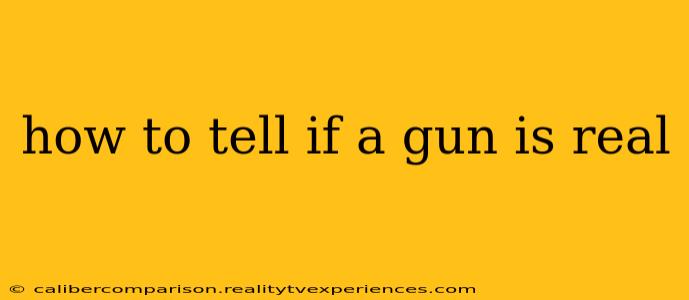Accidental shootings and intentional misuse of imitation firearms are tragically common. Knowing how to distinguish a real firearm from a replica is crucial for safety and can prevent serious injury or even death. This guide provides vital information on identifying real guns, emphasizing the importance of never handling any firearm you're unsure about.
Key Differences Between Real and Replica Firearms
The lines between real and realistic replica firearms can be incredibly blurry, making accurate identification challenging even for experienced professionals. However, there are several key characteristics to examine, keeping in mind that some sophisticated replicas might mimic these features. Always prioritize caution and err on the side of assuming a firearm is real.
1. Weight and Feel:
- Real Firearms: Generally feel significantly heavier and more substantial than replicas. The weight distribution is also different; real guns have a heft that's difficult to replicate.
- Replicas: Typically lighter and often made of plastic or less dense materials. The feel might be noticeably cheap or hollow.
2. Material and Finish:
- Real Firearms: Usually constructed from metal (steel, aluminum) or high-quality polymer. The finish is typically consistent and professional, with minimal imperfections.
- Replicas: Often made from less durable plastics. The finish may be uneven, with visible seams, imperfections, or inconsistent coloring.
3. Markings and Serial Numbers:
- Real Firearms: Possess clearly etched manufacturer's markings, model numbers, and serial numbers. These are usually deeply engraved and difficult to remove. The positioning and style of markings are consistent with the manufacturer.
- Replicas: May have markings, but they're often poorly executed, easily rubbed off, or inconsistently placed. The font and detail may differ from authentic markings.
4. Action and Mechanics:
- Real Firearms: The action (e.g., slide, cylinder) will function smoothly and realistically. The trigger pull will have a discernible resistance. Be extremely careful not to manipulate any part of a firearm; doing so could lead to accidental discharge.
- Replicas: Actions might feel loose, stiff, or inconsistent. The trigger might be overly light or feel completely different from a real firearm.
5. Safety Mechanisms:
- Real Firearms: Have visible and functional safety mechanisms (e.g., manual safety, decocker) that influence the firearm's ability to fire.
- Replicas: May have imitation safety mechanisms that don't actually function.
6. Ejection Port and Magazine Well:
- Real Firearms: Have appropriately sized and functional ejection ports and magazine wells, properly aligned with the barrel and internal components.
- Replicas: These features might be poorly aligned, improperly sized, or visually inconsistent with the overall design.
When in Doubt, Assume It's Real
The safest course of action is always to assume any firearm you encounter is real and treat it accordingly. Avoid handling it, and immediately contact the authorities or a qualified firearms expert. Never attempt to disassemble or test a firearm of questionable authenticity.
Seeking Professional Assistance
If you need to determine if a firearm is real, contact your local law enforcement agency. They possess the expertise and equipment to safely assess the situation and handle the firearm appropriately.
Disclaimer: This guide is for informational purposes only. It should not be considered a substitute for professional training or guidance on firearm safety. Always prioritize safety and seek expert assistance when dealing with any firearm of uncertain origin.

